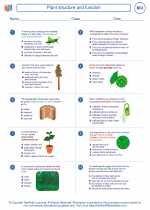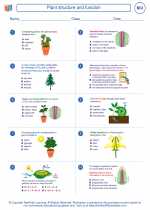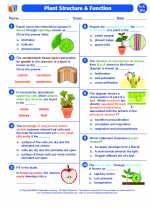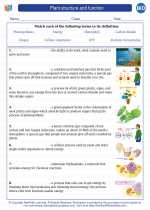Plant Structure and Function
Plants are complex organisms with specialized structures that allow them to carry out essential functions such as photosynthesis, reproduction, and support. Understanding the structure and function of plants is crucial for comprehending the principles of biology and ecology.
Key Concepts
- Cellular Structure: Plants are composed of cells, which are the basic unit of structure and function.
- Roots, Stems, and Leaves: These are the main organs of a plant, each with specific functions.
- Photosynthesis: The process by which plants convert light energy into chemical energy.
- Transport Systems: Plants have specialized tissues for the transport of water, nutrients, and sugars.
- Reproduction: Plants reproduce sexually or asexually, and have unique structures for this purpose.
Cellular Structure
Plants are composed of eukaryotic cells, which have a cell wall, chloroplasts, and a large central vacuole. The cell wall provides structure and support, while chloroplasts are the site of photosynthesis. The central vacuole stores water and helps maintain turgor pressure.
Roots, Stems, and Leaves
Roots: Anchor the plant, absorb water and nutrients from the soil.
Stems: Provide support and transport water and nutrients between roots and leaves.
Leaves: Main site of photosynthesis, exchange gases with the environment.
Photosynthesis
Photosynthesis occurs in the chloroplasts of plant cells. Carbon dioxide and water are converted into glucose and oxygen in the presence of light. This process is essential for the production of food and oxygen on Earth.
Transport Systems
Xylem: Transports water and minerals from roots to the rest of the plant.
Phloem: Transports sugars produced during photosynthesis to other parts of the plant.
Reproduction
Plants can reproduce sexually through the formation of seeds, or asexually through methods such as fragmentation, budding, or spore production. Flowers are the reproductive structures of angiosperms, while cones serve this function in gymnosperms.
Study Guide
Here are some key points to focus on when studying plant structure and function:
- Identify and describe the different types of plant cells and their functions.
- Explain the role of roots, stems, and leaves in plant growth and development.
- Discuss the process of photosynthesis, including the reactants, products, and the role of chloroplasts.
- Compare and contrast the functions of xylem and phloem in plant transport.
- Describe the reproductive structures and methods of plants, including both sexual and asexual reproduction.
Understanding plant structure and function is essential for appreciating the diversity and importance of plant life on Earth.
.◂Biology Worksheets and Study Guides High School. Plant structure and function

 Worksheet/Answer key
Worksheet/Answer key
 Worksheet/Answer key
Worksheet/Answer key
 Worksheet/Answer key
Worksheet/Answer key
 Vocabulary/Answer key
Vocabulary/Answer key
 Vocabulary/Answer key
Vocabulary/Answer key
